April 14 - April 29, 2016
At the end of their studies, each art major is required to develop and present a coherent body of self-generated work. This exhibition combines their knowledge of techniques and concepts while drawing on research of historical and contemporary artists.
Wasmer Gallery
Michael Salmond and John Loscuito, Faculty Mentors
Sponsored in part by U. Tobe, The Smith Family Foundation of Estero, Palette Pals of the United Church of Christ, and WGCU Public Media
-
Rachel Bass DECONSTRUCTION: CHALLENGING THE PRIVILEDGE OF DENIAL
Toggle More Info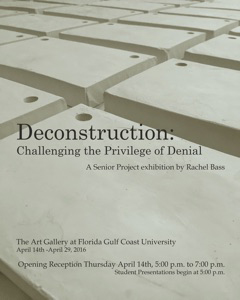 The foundation of our country was built on white supremacy. We declared that all men were created equal at the same time that we enslaved African people and forced them to build our country upon stolen land. Today, one hundred fifty one years since the thirteenth amendment abolished slavery, we are much closer to that concept, but we still fall short. There has never been a time in our nation’s history where we have not struggled with the concept of racial equality. We have built our institutions and written our laws in ways that silently reinforce white supremacy through systemic racism.
The foundation of our country was built on white supremacy. We declared that all men were created equal at the same time that we enslaved African people and forced them to build our country upon stolen land. Today, one hundred fifty one years since the thirteenth amendment abolished slavery, we are much closer to that concept, but we still fall short. There has never been a time in our nation’s history where we have not struggled with the concept of racial equality. We have built our institutions and written our laws in ways that silently reinforce white supremacy through systemic racism.It is not always apparent, especially for someone like me who only experiences the world as a white person, to see how our laws and institutions disadvantage people of color. When presented with evidence of such, often our first line of defense from the shameful truth is denial. We have the privilege to ignore, deny, and make excuses for problems that we do not experience firsthand. Even when we do acknowledge that racism exists, we tend to think of it as a problem to be solved by people of color. We do not see our own role in it, we do not own slaves, we no longer use the “N-word,” and we even have black friends and family members. We therefore believe that we can claim the privileged status of colorblindness. Our individual and collective silence then leaves the entire burden of racism on the shoulders of those who experience it.
I made one hundred fifty one plaster bricks, one for each year since slavery was abolished in our country. Each brick is inscribed with a commonly used phrase that denies or excuses racism. The repetition present in the bricks alludes to the way we no longer question the validity of the statements, because we hear and repeat them so often. I am inviting participants to challenge their own privilege of denial by removing a brick and taking it away. As the bricks are removed, statistics and facts on racism and its effects will be revealed on the gallery wall. My project will be completed by the participants through the removal or the leaving behind of the bricks. It is my hope that through this deconstruction, conversations will be initiated among those of us who otherwise have the privilege to stay silent.
-
Knoel Blake SELF JUDGEMENT
Toggle More Info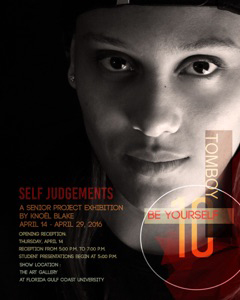 Self Judgements is a project that examines and illustrates the way women judge themselves and how that thought system should change. Women often see themselves as inadequate or failing by placing too much emphasis on the quantitative numbers that represent their body shape or size. Who a woman is as a person should not be decided by some numbers that make no difference or actual impact. Pant size, weight on the scale, bra size, height, and shoe size are numbers that can heavily influence women. This project sends a challenge to women that if they are to judge themselves by numbers they should instead look at all the positive numbers in their lives that make an impact on who they are as a person, not just appearance. There are positive aspects, impactful events, people, and times in a woman’s life so much more worthy for her to judge herself by than superficial numbers. Those numbers need to be called to attention for each woman. This is the aim of this project, to change how women look at all these numbers.
Self Judgements is a project that examines and illustrates the way women judge themselves and how that thought system should change. Women often see themselves as inadequate or failing by placing too much emphasis on the quantitative numbers that represent their body shape or size. Who a woman is as a person should not be decided by some numbers that make no difference or actual impact. Pant size, weight on the scale, bra size, height, and shoe size are numbers that can heavily influence women. This project sends a challenge to women that if they are to judge themselves by numbers they should instead look at all the positive numbers in their lives that make an impact on who they are as a person, not just appearance. There are positive aspects, impactful events, people, and times in a woman’s life so much more worthy for her to judge herself by than superficial numbers. Those numbers need to be called to attention for each woman. This is the aim of this project, to change how women look at all these numbers.I myself suffer from body image issues. I have lead a very successful academic life in university. I have achieved many accomplishments and travelled to a number of places. However, none of that made a difference on how I viewed myself because in my mind the number on the scale labeled me a failure, overriding all that I have accomplished. This seemed wrong and this is where the project started. Finding myself so chained down, and depressed over numbers that do not determine who I am as a person, I decided to look at the positive numbers instead.
Self Judgements is a video-based project, consisting of videos of female participants, discussing the negatives they judge themselves by, and then reflecting on the positive things they often forget. Visuals show the crippling negative numbers and then the great number of positives as women reflect on them. The video is projection mapped onto three different panels. There are posters accompanying the videos to help capture the emotion of the project in a few still snapshots.
-
Cassie Bretagna REMNANTS OF FLESH & BONE
Toggle More Info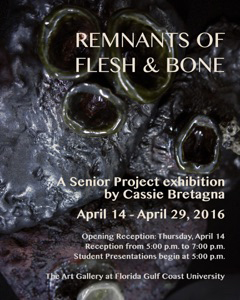 When most people think about the oxygen we breathe, the first thing that comes to mind is trees. Although trees are important for food, oxygen and habitats to many animals, there is one thing that people do not realize that is just as important in providing us with oxygen, food, protection, and habitats to thousands of animals, and that is the ocean. The ocean is responsible for the water cycle making it possible for us to have fresh water and it also plays a role in absorbing a quarter of all of the carbon dioxide in the earth’s atmosphere so it can thus, produce back oxygen. However, our oceans have become under threat due to our obsessive use of fossil fuels, overfishing, pollution, oil spills, and climate change which is causing warming seas, ocean acidification, coral bleaching, and loss of species due to the astronomical amount of carbon dioxide caused by human activity.
When most people think about the oxygen we breathe, the first thing that comes to mind is trees. Although trees are important for food, oxygen and habitats to many animals, there is one thing that people do not realize that is just as important in providing us with oxygen, food, protection, and habitats to thousands of animals, and that is the ocean. The ocean is responsible for the water cycle making it possible for us to have fresh water and it also plays a role in absorbing a quarter of all of the carbon dioxide in the earth’s atmosphere so it can thus, produce back oxygen. However, our oceans have become under threat due to our obsessive use of fossil fuels, overfishing, pollution, oil spills, and climate change which is causing warming seas, ocean acidification, coral bleaching, and loss of species due to the astronomical amount of carbon dioxide caused by human activity.Humans have had a negative impact to the environment, thus negatively impacting ourselves. Just as humans get diseases, so do the coral reefs. It is vital to remember that every drop of water you drink, or breath you take you are connected to the ocean, and in-turn, the coral reefs. My goal as an artist is to shed light on this serious matter and to make known that humans and nature are one and when we harm the ocean and coral reefs we are consequently, harming ourselves and the state of our planet as a whole.
As an artist I achieve conveying this tragedy through clay sculpture. Clay is a material that comes from the earth and shares some of the same chemical properties that the coral do as well as represent their fragility. Forms I used such as brain coral, are meant to symbolize a human brain to connect the ocean to the human brain as a metaphor that we need to start becoming more aware of what we are doing to ourselves and our planet. I hand-built all of my sculptures using minimal carving tools & used two firing methods. I used raku, which consists of taking the piece out of an 1800°F kiln and placing it into a dirt pit filled with combustibles. I also used saggar firing which consists of hand-building a brick kiln and filling it with hay & wood, adding in salt, then copper oxide and iron oxide as coloring agents and lighting it on fire. Both methods embrace taking beautiful, nature elements and throwing them into a fire, which I believe emulates what humans are doing to the environment.
The ocean has been an important place in my life since I can remember. It reminds me of all of the fun family vacations I had and the places I grew up around exploring. Many of my memories that I have with my family and friends took place while relaxing and enjoying all of the beaches wonders. The ocean and the coral reefs are dear to me and are worth protecting not only because their beauty and wonderful memories I have with it, but for the existence of our planet!
-
Madison Chaffe VOYAGE
Toggle More Info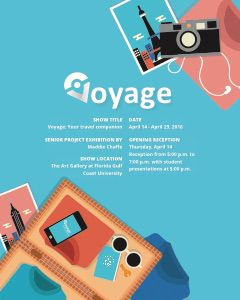 FORT MYERS, Fla. (April 14, 2015) – Voyage, a new and innovative travel app that seeks to create a travel community for its users, launches today! CEO of Voyage, Maddie Chaffe, came up with the concept for Voyage and designed the app in Senior Project. Voyage fulfills the desire humans have to find connection with others while exploring new territories.
FORT MYERS, Fla. (April 14, 2015) – Voyage, a new and innovative travel app that seeks to create a travel community for its users, launches today! CEO of Voyage, Maddie Chaffe, came up with the concept for Voyage and designed the app in Senior Project. Voyage fulfills the desire humans have to find connection with others while exploring new territories.Voyage provides its customers with a sense of community while traveling. The app offers customers local “matches” that the user, or “traveler”, can choose to explore the area with while visiting their destination. The product matches its travelers based on age, location, and popularity. When a traveler arrives at their destination, finding a new friend to explore with is now as simple as opening an application on their phone. Customers simply download the app, create a travel profile, and choose the “Connect” option to find travelers in the area, which are either ranked by the highest user rating or closest proximity to the user. Users can also communicate with one another through the application, and find local attractions to visit based on their moods.
“Providing users of Voyage the ability to connect with fellow travelers when they reach their destination will open new doors for travelers and ultimately change the way they view travel.” Says CEO of Voyage Maddie Chaffe. “I created the app prototype digitally using Adobe Illustrator and InDesign. My inspiration for the app came from my personal goal to travel and visit new and exciting areas while also meeting new people.”
-
Genie M. Clarke GEOMETRIC MUSINGS
Toggle More Info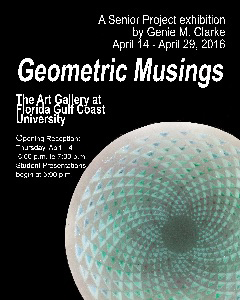 This series of work fuses my love of art and meditation together through the use of sacred geometric patterns, light and color. My contemplative practices of yoga, meditation, music, and art therapy are reflected in the process and the end result of my work. These contemplative practices act as a release from the pressures of society providing me with improved balance between mind, body, emotions, and spirit. Therefore, my work was carefully composed to support contemplative practices and stimulate a harmonious affect on its viewer.
This series of work fuses my love of art and meditation together through the use of sacred geometric patterns, light and color. My contemplative practices of yoga, meditation, music, and art therapy are reflected in the process and the end result of my work. These contemplative practices act as a release from the pressures of society providing me with improved balance between mind, body, emotions, and spirit. Therefore, my work was carefully composed to support contemplative practices and stimulate a harmonious affect on its viewer.I chose mandalas, yantras, and sacred geometry patterned designs, not only for their symbolism, but for their symmetrical, repetitious geometric composition. The repetition and tedious construction of these designs evoke a steady, calm, meditative process. I am inspired by Eastern philosophies and likewise influenced by colorful geometric nonrepresentational designs found across many cultures. I’ve been continuously motivated to translate energy through my work, not only by the development of patterns, textures, and colors, but through the incorporation of light. Influenced by James Turrell's light studies, Mark Rothko’s color filed paintings, and Narcissus Quagliata’s light painting techniques my work has become sensitive to the mood or affects that light, color, and intensity creates. Embracing the element of light in my sculptural work has pushed me toward my current medium of warm glass.
Through a simple fusing technique I am able to color glass. Inspired by contemporary glass artist Narcissus Quaggliata and the idea of painting with light, I too am working with fritt, or crushed colored glass, which is fused to a single sheet of glass and enhanced with the medium of light. The powder fritt is sifted over a hand cut sacred geometry stencil that leaves a negative image in the powder color field. The glass and fritt design then undergo a fusing and annealing process in a glass kiln. The glass is complimented with an additional layer of etched glass, which is sandblasted with the same stencil. The layers of glass are then accented with layers of cut, colored paper and plastic and displayed in a mandala formed light box.
-
Cherise Fortella THE ADVENTURES OF MOLLY WHUPPIE
Toggle More Info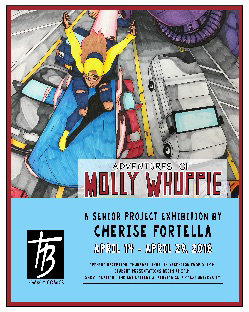 Taking from myth and legend stories as many modern tales do, I extracted the tale told in this series from the old story of Molly Whuppie. The story is of a courageous young woman; one who is strong and can take care of herself and her sisters. Turning it into a comic book tale, the focus was to show Molly as a tomboy character different from the way female characters are general portrayed in comics. Women in comics are often over sexualized and expected to be very feminine even if they are strong. This series poses a different way of showing these characters. A cover captures attention and this is the reason why I chose to focus on the art of the covers of comic books, which in many cases determines if the reader is going to pick up the comic book and read it.
Taking from myth and legend stories as many modern tales do, I extracted the tale told in this series from the old story of Molly Whuppie. The story is of a courageous young woman; one who is strong and can take care of herself and her sisters. Turning it into a comic book tale, the focus was to show Molly as a tomboy character different from the way female characters are general portrayed in comics. Women in comics are often over sexualized and expected to be very feminine even if they are strong. This series poses a different way of showing these characters. A cover captures attention and this is the reason why I chose to focus on the art of the covers of comic books, which in many cases determines if the reader is going to pick up the comic book and read it.My work involves breaking down the general stereotypes of female comic book heroes. I chose instead to focus on a less stereotypical female hero, one that may be referred to as a tomboy. I want to focus more on a new female hero that is more relatable than the muscular heroes in mainstream comic books. In correlation, these ideas bring light to that of a tomboy heroine who is just as pretty as Supergirl and just as strong as Wonder Woman and like all superheroes, she’s been through her own struggles and overcame them by staying true to herself. I for one, have been through my own struggles, growing up as a tomboy, and overtime I have learned that it is important to stay true to myself. I have used this as a basis for Molly’s character as she grows up in a society that isn’t as accepting of her non-girly image, but eventually grows fond of her and her willingness to defeat the evildoers. I believe each person will take something a little different from the same body of work and I'm delighted with that.
The subject matter of each body of work is illustrated to make the viewer want to read the actual comic book and learn more about the story. Each scene was strategically drawn out and inked using pencil and pen. Once the initial shading was done, Copic markers and Prismacolor pencils were used to bring life to the Adventures of Molly Whuppie.
-
Rebecka Garnes BEKS INC.
Toggle More Info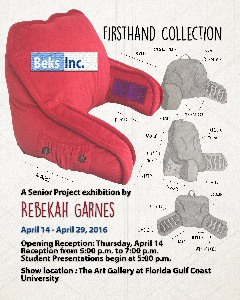 Beks Inc. announces the consumer launch of its new collection, which allows you to connect your personality with our products. Beks Inc. focuses around how product design serves as the communication between object and consumer, and how to optimize an emotional connection. These products are created to help us understand that our everyday designs serve more than their basic functions. Today, Beks Inc. introduces a collection of products with a sense of humor, the FirstHand Collection. This collection features three products that connect to our quirky, and desirable, humanistic behaviors. This collection includes the Precision Clock, the Companion Pillow, and the Pillow Remote (PillMote).
Beks Inc. announces the consumer launch of its new collection, which allows you to connect your personality with our products. Beks Inc. focuses around how product design serves as the communication between object and consumer, and how to optimize an emotional connection. These products are created to help us understand that our everyday designs serve more than their basic functions. Today, Beks Inc. introduces a collection of products with a sense of humor, the FirstHand Collection. This collection features three products that connect to our quirky, and desirable, humanistic behaviors. This collection includes the Precision Clock, the Companion Pillow, and the Pillow Remote (PillMote).The FirstHand Collection advertises these designs with a sense of intention and emotion behind each product. Using a combination of Photoshop and After Effects, today Beks Inc. has launched this suite of products…
The FirstHand Collection contains all of Rebekah’s favorite products based on her quirky habits that she does on regular basis, including things like:
- The Precision Clock: Focuses on her slight neurotic behavior when it comes to keeping track of time.
- The Companion Pillow: Symbolizes our desire for longing and comfort, whether it’s to relax after a long day at work, or hold on to something for comfort and ease.
- The PillMote (Pillow Remote): Saves Rebekah the embarrassment from falling asleep on her TV remote and waking up with it imprinted on her skin.
“Beks Inc. is the inspiration and brain-child behind the self-reflection of my peculiar habits,” said Rebekah Garnes, CEO. “These designs allow customers to experience the feedback and/or reaction they desire out of their everyday products, just like me.” The FirstHand Collection is all about taking simplistic and common designs and encouraging a more personal and emotional connection with them.
-
Simon Huebler MOMENTA
Toggle More Info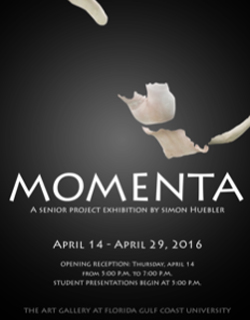 For my entire life I have been subject to vivid and realistic dreams almost every night. These dreams can sometimes seem that they are going on for days or only a few minutes. What I find interesting about my vivid dreams is the hiatus in which we cross to wake up from our dreams.
For my entire life I have been subject to vivid and realistic dreams almost every night. These dreams can sometimes seem that they are going on for days or only a few minutes. What I find interesting about my vivid dreams is the hiatus in which we cross to wake up from our dreams.I have been experiencing falling dreams quite often and I rarely actually fall out of bed, but I still get the sensation of just being snatched out of the air while freefalling. This sensation is our bodies simulating a free fall. We have fluid filled membranes in our ears that usually help us with balance and other outside forces on our bodies. While dreaming and “falling” in our unconscious our bodies jerk and move this fluid in our inner ear, with a lot of force, simulating that we in fact are freefalling. This jerking motion is a form of parasomnia and usually results in the person falling off the bed, enhancing the sensation even more. I wish to explore this bridge between the unconscious and reality, where we can sometimes feel pain or shock, and also be subjected to simulated forces like falling.
The three pieces are suspended human forms that are face upwards and floating in the air, the point of bridging the gap of dreaming to reality. The body forms are fragmented to illustrate how we are present within the dream but absent from reality, The disjointed bodies and no heads, symbolize cognitive thought and actuality. The pieces are painted white to symbolize the dream state; most of my dreams take place in pure white landscapes. The height of each of the pieces varies to imply progressive states of falling.
The materials for the three sculptures are hand forged steel and life cast automotive filler. For the armature in each piece I used steel that had been painted white to give the pieces are weightlessness quality, also give a gestural component to the body. The fragmented body pieces are made using plaster bandage molds off of myself and then cast with an automotive filler, for strength and weather resistance. The parts have been painted and sealed and then bolted to the forged framework.
-
Janine Krench SOJOURN OF FUTURE PAST
Toggle More Info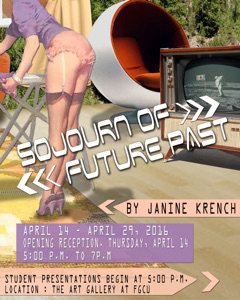 Over fifty years ago, on May 25, 1961, President John F. Kennedy gave a historic speech before a joint session at congress that set the United States on a course to the moon. Kennedy called for an ambitious space exploration program that included not just missions to put astronauts on the moon, but also a Rover nuclear rocket, weather satellites and soon to also put people in space. Unfortunately shorty after Kennedy’s famous speech he was assassinated in 1963, and he never lived to see his dream come to fruition. But what if Kennedy had lived? What if the dream of 1955-1969 came true and we moved not only American’s, but also the world to the moon, other planets, other solar systems? How would the world react in space? Would there still be a Cold War going on, and fear of communism, or would the world start over?
Over fifty years ago, on May 25, 1961, President John F. Kennedy gave a historic speech before a joint session at congress that set the United States on a course to the moon. Kennedy called for an ambitious space exploration program that included not just missions to put astronauts on the moon, but also a Rover nuclear rocket, weather satellites and soon to also put people in space. Unfortunately shorty after Kennedy’s famous speech he was assassinated in 1963, and he never lived to see his dream come to fruition. But what if Kennedy had lived? What if the dream of 1955-1969 came true and we moved not only American’s, but also the world to the moon, other planets, other solar systems? How would the world react in space? Would there still be a Cold War going on, and fear of communism, or would the world start over?In Kennedy’s eyes all of this was possible with the American spirit, it was the ultimate American dream. I was curious what this ideal space future would look like. I know the cliché dreams of hover crafts and super smart technology, but all of those fantasies happened on Earth, I feel like no one ever developed what the future would look like if the space exploration program truly took off.
For my project I wanted to explore other planets, dimensions, and futures from the perspective of an American woman living in the time period of 1954-1969. In this time period the Dream was the ‘white-male’ dream, women were basically servants, maids, and homemakers, there were no minorities in this dream, or powerful women. I want the idea of living in space, the ultimate frontier to be as endearing and a part of the American Dream, and to do that I want to strike the emotional appeal of families in this time period to believe living in space is the way to go.
Materials: I used found images in multiple LIFE magazines, old postcards, records, biography books, awesome flea market finds, and a few images found online.
-
Alexis Lizotte AFFECTIVE CULTIVATION
Toggle More Info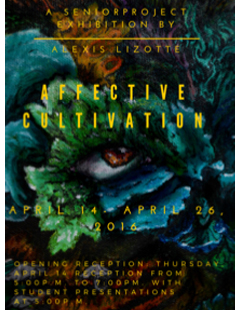 The work in this exhibition reflects an extreme version of emotional states made visible through symbiotic relationships with plants. The skin is one of the first physical features of a person that we notice, and the human condition can be viewed simply by looking at an individual’s skin. There is a physical record of their life having a connection to all the scars, wrinkles, stretch marks, and the general wear and tear of going through life. However, there is a more elusive detail that can easily be overlooked, but still manage to resonate on the outside. The inner conflicts involving mental and emotional strife are what eludes the surface, but can still leave traces of an individual's psychological state.
The work in this exhibition reflects an extreme version of emotional states made visible through symbiotic relationships with plants. The skin is one of the first physical features of a person that we notice, and the human condition can be viewed simply by looking at an individual’s skin. There is a physical record of their life having a connection to all the scars, wrinkles, stretch marks, and the general wear and tear of going through life. However, there is a more elusive detail that can easily be overlooked, but still manage to resonate on the outside. The inner conflicts involving mental and emotional strife are what eludes the surface, but can still leave traces of an individual's psychological state.It has been known that the chemical reactions that occur within the body, such as when an individual experiences terrible stress, can become the source of breakouts of acne, rashes, bumps, hives and other afflictions on their skin. Stress is our body's reaction to any type of change that requires an adjustment with a physical, emotional, and mental response. When in an extreme emotional or psychological state, an individual can push reality to the wayside and people within that reality simply become a blur in the background. Soon everything seems to come out of focus and unique individuals become featureless shapes in that state of being overwhelmed with negative emotions. While retaining the presence of stressors, the skin also plays host to thousands of species of microbes, bacteria, and fungus. Skin microbiota is the ecological community of commensal, symbiotic and pathogenic microorganisms that share the same space as our bodies. Emotions manifest themselves in a physical state with the symbiotic relationship that our skin has with these microorganisms within this series of work.
The process of creating this series of paintings began with conceptual sketches that would outline the general layout of the painting. A second general sketch was then made on the canvas and a base color was distributed in the designated areas according to the design. Color is an important element within my work and the brightness of the colors reflects the chemical reactions from the emotions being translated. Each concept is meant to depict the emotional state in a physical and symbolic way that communicates the perception of an individual’s state of mind.
-
Felipe Maldonado REGENERATION
Toggle More Info The human experience proves the high level of curiosity we hold. We are constantly searching for a new meaning; whether it is in ourselves or in our exterior surroundings, we are constantly changing. Science would call this evolution, others adaptation and some, even survival. Why must our ability to change and adapt sound so harsh? We see it as leaving the old behind and embracing the new, but we should embrace the old and learn from the new.
The human experience proves the high level of curiosity we hold. We are constantly searching for a new meaning; whether it is in ourselves or in our exterior surroundings, we are constantly changing. Science would call this evolution, others adaptation and some, even survival. Why must our ability to change and adapt sound so harsh? We see it as leaving the old behind and embracing the new, but we should embrace the old and learn from the new.My creative process is cultivated through self-discovery and the understanding of decisions and their impacts. I embrace clay as a tool of creation and directly link my hands as a guide for creating inanimate life. This results in work that is highly influenced by the ideas of movement and connection. Taking away from daily activities, using a different mindset and allowing the clay and I to have a conversation, coming to a common ground that we can both agree on. This idea begins to touch more on the discovery of movement that my pieces show and allows my work to express a dance between myself, as the potter and my pieces, as my partner. The creation of my pieces allows the idea of pairing to come to life and give the ability for the practice of connection between people to be embraced. This connection creates a sense of place for the individual pieces and allowing people the ability to come together to connect further.
I took Domestic Stoneware and created slabs of clay that would serve as the base for the large platters; I then extruded a thick coil and applied it to serve as the rim of the platter. After throwing the two pieces on the potter’s wheel, I then folded the large rim inward to create a frame for the platters and applied a subtle push of the rim to create movement in the piece. The pieces are then decorated in white slip, have a transfer image applied and are waxed. The remaining waxed white space is carved away and inlayed with a black underglaze to enhance the carving marks. The pieces are then bisque in an electric kiln, where they go to cone 08 (1728 degrees,) once bisque the pieces are taken out and prepped through a meticulous process of glazing that is all done with a spray gun and different pressures in various sections for different results to then be fired off in the gas kiln to cone 10 (2300 degrees.)
-
Leila Mesdaghi PRIVILEGE OF REMOVAL
Toggle More Info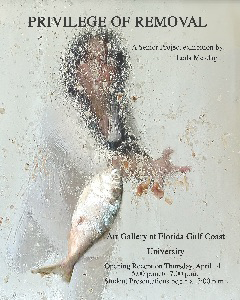 Privilege is a benefit, an advantage, a reserved right, or an immunity granted to a particular person or a group of people. Privilege allows someone to do something which others cannot do. It can take the form of an experience or a particular act, as simple as having the choice to look away and remove themselves, to avoid the painful emotions that are associated with the witnessing of the suffering of the others. “Privilege of Removal” is about our relationships and how we relate to the “others” in the universal sphere; the ones we are not related to, the ones we cannot relate to, and the ones we do not give a damn about.
Privilege is a benefit, an advantage, a reserved right, or an immunity granted to a particular person or a group of people. Privilege allows someone to do something which others cannot do. It can take the form of an experience or a particular act, as simple as having the choice to look away and remove themselves, to avoid the painful emotions that are associated with the witnessing of the suffering of the others. “Privilege of Removal” is about our relationships and how we relate to the “others” in the universal sphere; the ones we are not related to, the ones we cannot relate to, and the ones we do not give a damn about.In “Privilege of Removal” I challenge how we observe, react, and respond to social and political issues. We watch real life behaviors of physical, verbal, and moral abuse on T.V and computer screens, and instead of rejecting, we justify and accept them as socio-political norms. By literally throwing dead fish at a pane of glass, I act as a violent exhibitionist and remind the viewer of our silent voyeuristic nature. I smashed dead fish against the barrier that separates the world we live in from the world we witness. I chose a remote and private location, where there once used to be a residential facility for people with development disabilities, to relate to those who had been rejected by their immediate families. The physical location of the performance became important to me as it became a metaphor of where moral and social responsibilities meet.
Just because we have the privilege to look from a distance and the privilege to remove ourselves, problems do not end and people do not stop suffering. Just because we send decorated cans of food to Africa and Haiti does not mean that we have compassion and are ending hunger, homelessness, and wars. Every move a privileged person makes has a cost, and the cost is the “suffering of the others.”
This project is the outcome of a labor of love. I owe a great debt to Mila Bridger for photographing the performance, Cezar Aguilera for documenting it, and Harold Elie for installation.
-
Christopher Miller NATURAL ABSTRACTIONS
Toggle More Info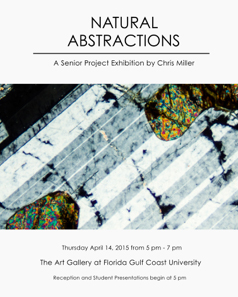 I was introduced to photography at a very young age. I remember my first photos I took were at a summer camp when I was around 11 years old. Ever since then photography has always been an interest of mine. Over the years I have honed my abilities by exploring various photographic techniques, from simple portraiture to long-exposure landscapes, even astrophotography. However, over the last couple of years at FGCU I found my work to deal more with science and scientific theory, rather than traditional subject of fine art.
I was introduced to photography at a very young age. I remember my first photos I took were at a summer camp when I was around 11 years old. Ever since then photography has always been an interest of mine. Over the years I have honed my abilities by exploring various photographic techniques, from simple portraiture to long-exposure landscapes, even astrophotography. However, over the last couple of years at FGCU I found my work to deal more with science and scientific theory, rather than traditional subject of fine art.There are many interesting shapes and patterns, found in nature, which have an artistically aesthetic quality to them. Sometimes all you have to do is look up into the sky or look into a pool of water to see them. But in order to see the true beauty of nature, sometimes you need a microscope and something as mundane as rock. You would be surprised at the intricate, abstract patterns and vibrant colors of the minerals found within certain types of rocks. Who knew something so seemingly boring could turn out to be something beautiful?
In order to capture these images, I needed to utilize special equipment. First I needed a microscope that could be converted to use imaging equipment. Luckily, FGCU’s geology department has such a microscope. With the help of James MacDonald, I was able to capture these abstract images that were created deep underground thousands of years ago, and present them to you today.
-
Andrew Mullen BUCEROTIDAE
Toggle More Info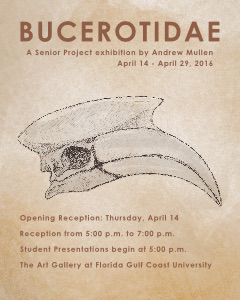 As I have grown as an artist, I also have learned exactly what lies beneath my work, and my purpose for creating. I want people to be excited. My goal is that someone looking at my art is just as involved in it as I am. The idea is that I want to give someone the same pure interest that I experienced as I was creating the work. If I wasn't intrigued by the subject, if I wasn't filled with excitement every time I thought about my artwork, then why should I expect someone else to feel excitement while the art's creator couldn't?
As I have grown as an artist, I also have learned exactly what lies beneath my work, and my purpose for creating. I want people to be excited. My goal is that someone looking at my art is just as involved in it as I am. The idea is that I want to give someone the same pure interest that I experienced as I was creating the work. If I wasn't intrigued by the subject, if I wasn't filled with excitement every time I thought about my artwork, then why should I expect someone else to feel excitement while the art's creator couldn't?A theme within my prior work has been the incredible potential found within animals, envisioning how a species could change after human influence. This influence is usually a change directly impacting the environment in a way that normally would be viewed as negative. I'm not interested in creating a gloomy scene of a near-apocalyptic world. I want to instead fill my viewers with a pure sense of wonder, the idea that there is something alive that holds this much potential.
Moving forward, I searched for a species I could expand upon. I soon decided the Hornbill species would be the one for my series, as the bird is both full of intrigue and already is a diverse species, making it the perfect candidate for a future form. I first chose a human impact catalyst, specifically the decline of rainforests after heavy logging. Hornbills are rainforest birds, and I wanted to observe how the species could change in reaction to a new habitat. To envision this, it was necessary that I understood the species, from bones to feathers. Detailed knowledge of the various types of hornbills assisted me in developing my imagined version, as I was able to pull features from multiple types. My hope is that I produced a new line of species that is both incredible and believable, that a greater understanding of the species’ potential is understood.
-
Ashley Niebles UNDRESSING THE FLAWS
Toggle More Info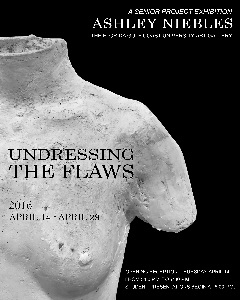 The moment I was introduced to Wabi Sabi I became fascinated with the concept and completely changed my perception on the simplest of things. What is ugly? Imperfect? Unfinished? Who decides the meaning of these words? As humans, we tend to disregard anything that falls under the category of those words. Wabi sabi is the opposite of that; it is the acceptance of all things imperfect, impermanent, and incomplete. I love the juxtaposition between the two, life and death, lightness and darkness, disagreeable and beautiful. With this project I aimed to convince my audience that there is beauty in the imperfect by creating wearable sculptures inspired by flaws in the human body caused by aging.
The moment I was introduced to Wabi Sabi I became fascinated with the concept and completely changed my perception on the simplest of things. What is ugly? Imperfect? Unfinished? Who decides the meaning of these words? As humans, we tend to disregard anything that falls under the category of those words. Wabi sabi is the opposite of that; it is the acceptance of all things imperfect, impermanent, and incomplete. I love the juxtaposition between the two, life and death, lightness and darkness, disagreeable and beautiful. With this project I aimed to convince my audience that there is beauty in the imperfect by creating wearable sculptures inspired by flaws in the human body caused by aging.I started to dig deep and really question what it is that I absolutely love doing, and my answer was anything fashion, photography, and sculpture related. I did tons of research and I came across avant-garde fashion and couture. After looking at multiple avant-garde fashion designers I realized it was in reality just wearable art, it was sculptural fashion.
I began this project by photographing the stretch marks surrounding my mom’s belly button and developed a sketch for a sculpture. Then I continued photographing my grandparents faces and bodies and developed the rest of my sketches. By abstracting these images and only focusing on the shapes, lines and curves I was able to see the beauty in the intricate details and forget these were things people tend to dislike about themselves. I narrowed down my sketches to the three I believed worked best with steel since that was the material I was using. I decided to pick a model with an ideally beautiful body and have her wear my sculptures for the photographs nude. By pairing a beautiful figure with sculptures based on “ugly” or “imperfect” flaws, people tend to find the pretty in the ugly. I created my own mannequins in order to have properly fitting sculptures by taking a mold of my model and cast plaster into them. After dealing with the issues of mold making and life casting I began to appreciate it more, the mannequins became more than mannequins, they became equally as important as the wearable sculptures.
-
Megan Olsen COMMON ORIGINS
Toggle More Info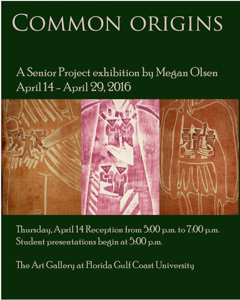 Our ancestors created a belief in spirits. They believed that all things had a spirit or a will and this is what created religion and worship. As our nomadic ancestors roamed the earth their views began to spread through story telling. The polytheists, or pagans, were open to mixing and matching other cultures’ gods or goddesses. Over time the stories of the gods began to become distorted, with some creationism stories explaining that humans came to be because the gods sculpted them from the earth, or they were whittled into existence from the bark of a tree. No matter what the story is, our ancestors all agreed on one factor, that we are earth’s children and this is what should be our connection to each other.
Our ancestors created a belief in spirits. They believed that all things had a spirit or a will and this is what created religion and worship. As our nomadic ancestors roamed the earth their views began to spread through story telling. The polytheists, or pagans, were open to mixing and matching other cultures’ gods or goddesses. Over time the stories of the gods began to become distorted, with some creationism stories explaining that humans came to be because the gods sculpted them from the earth, or they were whittled into existence from the bark of a tree. No matter what the story is, our ancestors all agreed on one factor, that we are earth’s children and this is what should be our connection to each other.As an artist I feel responsible to make my art tell stories that have a purpose. My artwork represents stories of creationism that stem from my desire to see how things are connected. I have always had an interest in mythological stories and what they might tell us about our world today. With these five stories (Greek, Norse, Chinese, Yoruban, and Egyptian) I wish to bring attention to religious views that are similar, showing the parallels of these ancient religions and what they may have in common with modern day monotheism. The beautiful thing about Pagan religions is the value of religious tolerance. I wish for people to learn from this as well as feel united by finding common ground in understanding the importance of the earth and our existence.
In a five by twelve foot bull denim tapestry I have created one version of creationism where each of the five stories can coexist. My process first started by painting the denim with watered down acrylics to get a watercolor look for my background. Then I created collagraph plates using paper, Masonite board, and gesso. My cloud collagraphs were used directly on the denim where I used oil pastel to rub and create sketch like copies. The rest of the plates were printed onto white chiffon material and unbleached muslin. These prints were then cut up and arranged to look like characteristic land mass. Finally, the pieces were hand quilted onto the denim. The idea of the sheer material for my giants is so that these figures could blend together and be part of one picture. I printed the creator gods and story details in muslin so they could stand out as focal points for the eye to follow.
-
Alexandrina Petrova TERRALO
Toggle More Info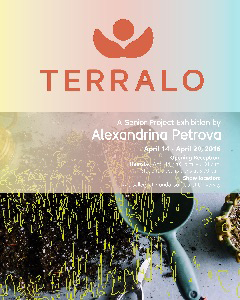 As citizens of planet Earth, we have a responsibility to care for the planet that provides us with our lives, so that it can continue to provide for future humans in the same way. One person cannot do this alone, but many can make small contributions that would make a change. With my project, I hope to inspire people to be environmentally aware and to start small gardens for plants that can be grown in their climate and location. This would have three key effects: fresher produce, psychological benefits through contact with nature, and a reduction in emissions from travel.
As citizens of planet Earth, we have a responsibility to care for the planet that provides us with our lives, so that it can continue to provide for future humans in the same way. One person cannot do this alone, but many can make small contributions that would make a change. With my project, I hope to inspire people to be environmentally aware and to start small gardens for plants that can be grown in their climate and location. This would have three key effects: fresher produce, psychological benefits through contact with nature, and a reduction in emissions from travel.My involvement with nature started from a young age when my grandparents managed their own farms in Bulgaria, a country whose population used to mainly rely on the crops grown by the villages. With the development of cities, younger generations began to stay away from the villages, leading to some young people today having little to no contact with the natural environment that is present in the villages, and no concern as to where their food comes from. Because of this, the farming communities are starting to go away little by little, some even becoming abandoned. The convenience and opportunities of city life is important, but I believe that being involved with the environment is essential to maintaining a sustainable society.
I have created Terralo, a campaign for a mobile app that would help people of all ages start small gardens. The introduction of this topic through technology would resonate with younger generations who have grown up around modern technology. The parts of this campaign include the app concept, two posters displaying how the app is being used, and a live garden. The posters and the app were created using Adobe Photoshop, Indesign, and Illustrator. The garden is a demonstration of how the app works.
-
Mike Rechkemmer THROWN TO THE WOLVES
Toggle More Info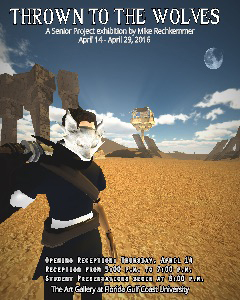 Thrown to the wolves is a grim visual experience with dark humor using narrative examination to give interactive choices using problem solving and actions to demonstrate a user’s struggle between various path options. Navigate a world set in a fictional setting, and investigate fragments of information through character interaction and vista locations. The experience will test the user’s skills of reaction, intelligence, and abilities to succeed or fail.
Thrown to the wolves is a grim visual experience with dark humor using narrative examination to give interactive choices using problem solving and actions to demonstrate a user’s struggle between various path options. Navigate a world set in a fictional setting, and investigate fragments of information through character interaction and vista locations. The experience will test the user’s skills of reaction, intelligence, and abilities to succeed or fail.You play as a main character who wears a mask in the shape of a wolf with the ability to bend time. He must discover the powers of other masks to gain new abilities and receive new weapons to be better armed for combat. Abilities will benefit puzzle solving as well as skillful executions. The story takes place in a recovering plagued world 200 years after the fall of a utopia. Resources are scarce, but society has been able to regrow, and tribes are formed for survival. Being raised in the small tribe of wolves, the leader of the tribe hopes to be crowned to create a new regime for all the capital cities and those who live in the wastelands. However, betrayal soon occurs after murdering the old king of the great city thus being sentenced to death by the new king, The Alpha Wolf.
Using Autodesk Maya to create 3D models, rig figures, and texture models using UV mapping and bump maps. Figures were applied to the game engine ‘Unity’ in combination with coding and animation. World assets were designed as ‘Kits’ which allows for time management and a larger world development. Inside of Unity, different AI characters were programed using the coding languages of C# and Javascript.
-
Samantha Weiss STOP & STARE
Toggle More Info No one person’s mind is the same as another, so there can be millions of interpretations of one single thing. Interpretations are based on the past experiences of each individual and are therefore more relatable and meaningful to the individual. Through these experiences, we subconsciously pick up on patterns throughout our existence that help us survive. When we come across a visual where there is no immediate discernable pattern or it appears to be confusing, our brains crave to find the pattern to restore back to homeostasis. With this in mind, I wanted to create works that involved both patterns and optical illusions that challenge the viewer’s perceptions on how he or she sees and processes a work.
No one person’s mind is the same as another, so there can be millions of interpretations of one single thing. Interpretations are based on the past experiences of each individual and are therefore more relatable and meaningful to the individual. Through these experiences, we subconsciously pick up on patterns throughout our existence that help us survive. When we come across a visual where there is no immediate discernable pattern or it appears to be confusing, our brains crave to find the pattern to restore back to homeostasis. With this in mind, I wanted to create works that involved both patterns and optical illusions that challenge the viewer’s perceptions on how he or she sees and processes a work.
I have always been curious about optical illusions and patterns for their visual appeal. The works show both complexity and simplicity all at once, and I find myself thinking more about these kinds of works that challenge my mind. With any work of art though, I like to find some type of meaning or symbolism that makes the work more relatable to myself. By doing this, I was always able to connect more with a work than by just the title, description, or other outside influence. Art is a form of humanistic expression, and even though everyone has his or her own opinions and ideas about a work, art is a universal language that connects us all. This idea of making connections is what Stop & Stare is all about; associating something physically there in front of you to something abstract, such as thoughts, feelings, and/or memories. I find the more challenging the work is to relate to myself, the more I think about the work until a connection is made. Once a connection is made, in my eyes, a work is complete.
All of my works started with a base design or pattern that was repeated throughout the whole work. After the base patterns were set, each of my three works were distorted in some way by manipulating multiple layers of the same design on top of each other and adding inverted layers to create color contrasts that made the works pop. The works were created digitally through Photoshop and are printed on foam core boards.
